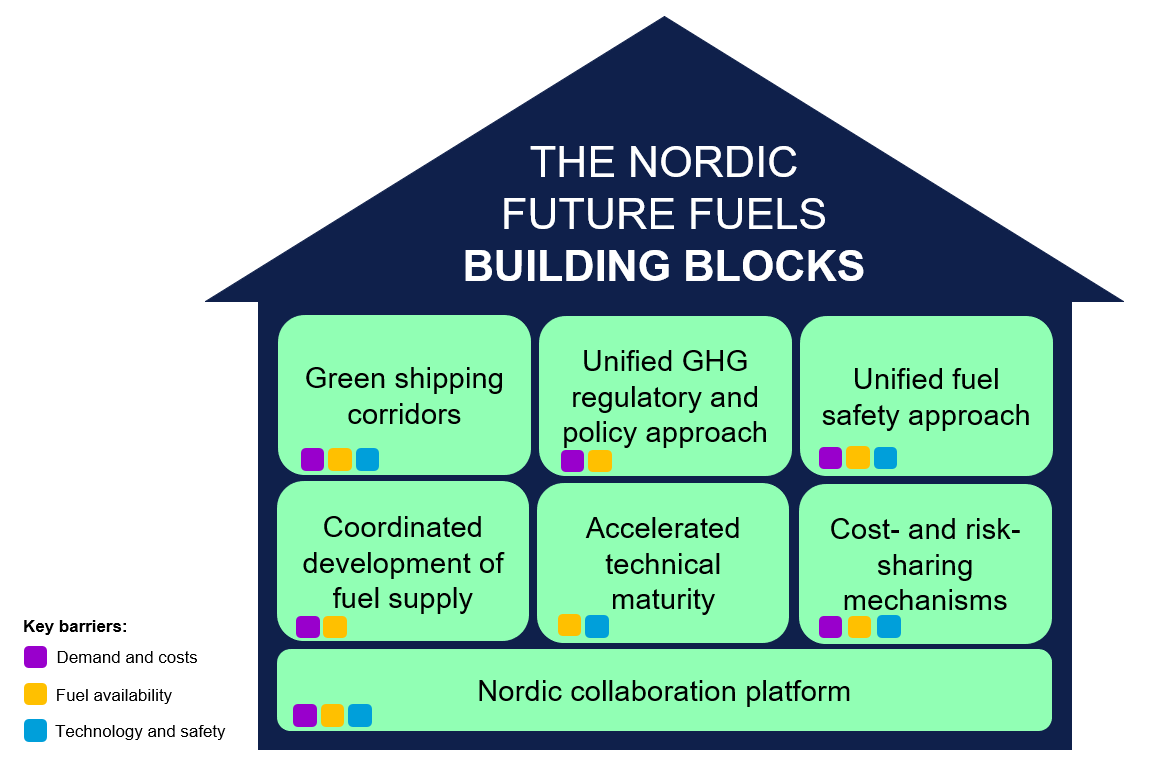Objective
To develop a strategy in the form of a Nordic Roadmap for establishing infrastructure to supply the new fuels.
Approach
The Nordic roadmap will list the selected fuels, provide a mapping of current status of these in the Nordic countries, apply decarbonization pathways for the future energy mix for shipping, investigate applicability and scalability of selected fuels and finally define long term goals; and major actions and milestones to reach these goals and to overcome barriers for supplying new fuels.
Background
The Nordic vision is to become “the most sustainable and integrated shipping region in the world”, and a global force for accelerating the green transition of the transport sector.
The 2023 IMO Strategy on Reduction of GHG Emissions from Ships has set the ambition for greenhouse gas (GHG) emissions from international shipping to reach net zero by 2050. In addition to supporting the 2023 IMO GHG Strategy and the commitments therein, the Nordic countries have also committed to the following climate targets for shipping:
- Declaration on Zero Emission Shipping by 2050 (COP26, November 2021)
- Clydebank Declaration for green shipping corridors (COP26, November 2021)
- Ministerial Declaration on zero emission shipping routes between the Nordic countries (May 2022), including an agreement to focus on the development of zero emission ferry routes between Nordic countries.
- Joint Statement by the Nordic Prime Ministers on a Sustainable Ocean Economy and the Green Transition (August 2022)
- Declaration on strengthening co-operation on energy to improve security of supply (October 2023)
The Nordic Fuel Transition Roadmap responds to the ambitious IMO strategy and the commitments listed above. It is a broad, unified, and well-anchored fuel transition strategy for Nordic shipping. The roadmap will provide confidence for the industry to invest in ships using zero-emission fuels, and the necessary fuel infrastructure to supply these ships. We need green shipping to make a green Nordic region. Without the right investments and decisions today, zero-emission shipping in 2050 will not be achieved.
The Nordic Fuel Transition Roadmap is a deliverable of the Nordic Future Fuels project, funded and initiated by the Nordic Council of Ministers in early 2022. The roadmap is developed by the project team led by DNV with members from Menon Economics, Litehauz, IVL, Chalmers, and Man Energy Solutions, and in close collaboration with industry partners. The work takes inspiration from and builds on the experiences from the Green Shipping Programme, as well as other domestic projects. The project has had a steering committee consisting of representatives of authorities in Norway, Sweden, Denmark, Finland, and Iceland.
Seven building blocks
This Nordic Fuel Transition Roadmap assumes that the fuel transition will follow an S-curve, where coordinated actions by all stakeholders in the preparation phase towards 2030 are essential for overcoming key barriers and reaching the first turning point.
The roadmap outlines seven key strategic building blocks to develop a market for zero-emission vessels and accelerate the uptake of potential zero-emission fuels in the Nordics, laying the foundation for upscaling in the next decade. Within each building block, specific actions towards 2030 are stated, addressing the three main barriers for the uptake of zero-emission fuels:
- Technology and safety – referring to the low maturity level of fuel technologies and safety regulations, both onshore and onboard vessels.
- Fuel availability – referring to the onshore development of the supply chain, including fuel production and sourcing of raw materials, distribution, and bunkering infrastructure.
- Demand and costs – linked to the lack of demand for zero-emission shipping and cost-competitiveness of zero-emission fuels.

The roadmap focuses on cross-Nordic actions and collaboration, and how the Nordics can support the global fuel transition and the ambitions in the 2023 IMO GHG strategy by showcasing and scaling up specific solutions.
The building blocks represent specific work packages that governments and industry stakeholders must work on together for the upscaling of zero-emission fuels. These building blocks will support the creation of a Nordic playing field where zero-emission fuels are cost-competitive, fuel supply is ensured, and the approach to fuel safety is aligned in the region.
Creating a common Nordic Future Fuels Playground with a unified approach to matters relating to zero-emission fuels may simplify some of the challenges the Nordic countries are facing in the fuel transition. The Nordics can be a first-mover region, driving progress and setting an example others can follow.
Input from partners: Contributing and supporting partners provide domain and regional expertise to the project deliverables primarily through project workshops, in-kind contributions and/or as pilot project participants.
Delivery
Publish a Nordic roadmap to assist decision and policy makers in each of the countries to set realistic goals that build on the needs of our combined shipping and logistics network (Task report).
Task leader: DNV (Dorthe Alida Slotvik)
Contributors: Menon, IVL, Chalmers, Litehauz, MAN ES
Start date: 2022 Q4
End date: 2025 Q4


